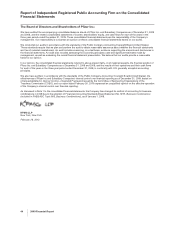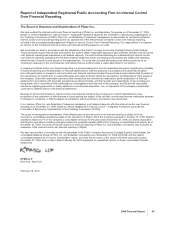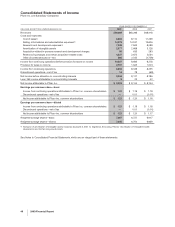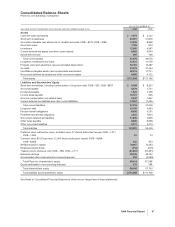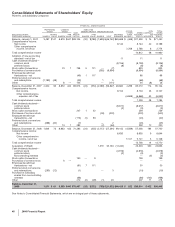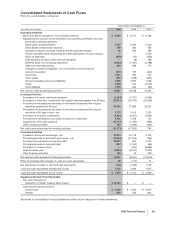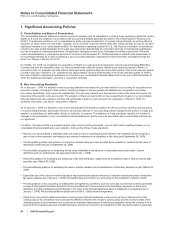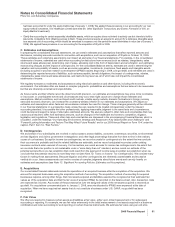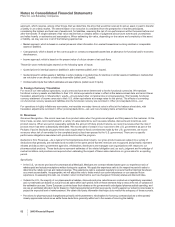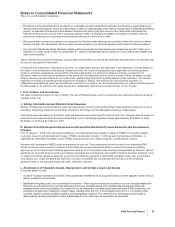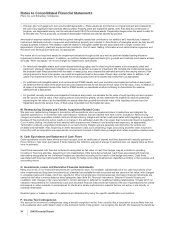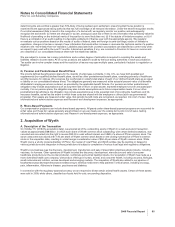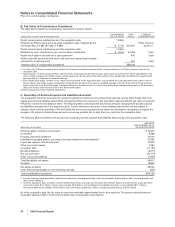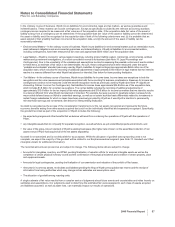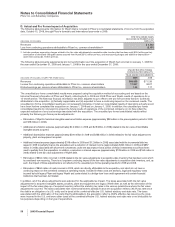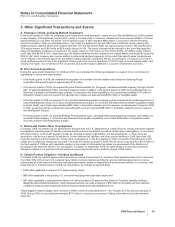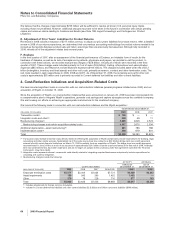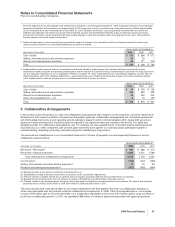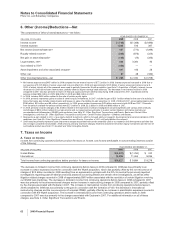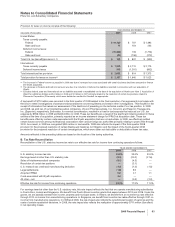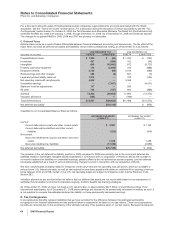Pfizer 2009 Annual Report Download - page 56
Download and view the complete annual report
Please find page 56 of the 2009 Pfizer annual report below. You can navigate through the pages in the report by either clicking on the pages listed below, or by using the keyword search tool below to find specific information within the annual report.
Notes to Consolidated Financial Statements
Pfizer Inc. and Subsidiary Companies
•Property, plant and equipment, less accumulated depreciation—These assets are recorded at our original cost and are increased by
the cost of any significant improvements after purchase. Property, plant and equipment assets, other than land and construction in
progress, are depreciated evenly over the estimated useful life of the individual assets. Depreciation begins when the asset is ready for
its intended use. For tax purposes, accelerated depreciation methods are used as allowed by tax laws.
Amortization expense related to finite-lived acquired intangible assets that contribute to our ability to sell, manufacture, research,
market and distribute products, compounds and intellectual property are included in Amortization of intangible assets as they benefit
multiple business functions. Amortization expense related to intangible assets that are associated with a single function and
depreciation of property, plant and equipment are included in Cost of sales, Selling, informational and administrative expenses and
Research and development expenses, as appropriate.
We review all of our long-lived assets for impairment indicators throughout the year and we perform detailed testing whenever
impairment indicators are present. In addition, we perform detailed impairment testing for goodwill and indefinite-lived assets at least
annually. When necessary, we record charges for impairments. Specifically:
•For finite-lived intangible assets, such as developed technology rights, and for other long-lived assets, such as property, plant and
equipment, whenever impairment indicators are present, we perform a review for impairment. We calculate the undiscounted value of
the projected cash flows associated with the asset, or asset group, and compare this estimated amount to the carrying amount. If the
carrying amount is found to be greater, we record an impairment loss for the excess of book value over fair value. In addition, in all
cases of an impairment review, we re-evaluate the remaining useful lives of the assets and modify them, as appropriate.
•For indefinite-lived intangible assets, such as brands and IPR&D assets, each year and whenever impairment indicators are present,
we determine the fair value of the asset and record an impairment loss for the excess of book value over fair value, if any. In addition, in
all cases of an impairment review other than for IPR&D assets, we reevaluate whether continuing to characterize the asset as
indefinite-lived is appropriate.
•For goodwill, annually and whenever impairment indicators are present, we calculate the fair value of each reporting unit and compare
the fair value to its book value. If the carrying amount is found to be greater, we then determine the implied fair value of goodwill by
subtracting the fair value of all the identifiable net assets other than goodwill from the fair value of the reporting unit and record an
impairment loss for the excess, if any, of book value of goodwill over the implied fair value.
M. Restructuring Charges and Certain Acquisition-Related Costs
We may incur restructuring charges in connection with acquisitions when we implement plans to restructure and integrate the
acquired operations or in connection with cost-reduction initiatives that are initiated from time to time. Included in Restructuring
charges and certain acquisition-related costs are all restructuring charges and certain costs associated with integrating an acquired
business (if the restructuring action results in a change in the estimated useful life of an asset, that incremental impact is classified in
Cost of sales, Selling, informational and administrative expenses and Research and development expenses, as appropriate).
Termination costs are a significant component of our restructuring charges and are generally recorded when the actions are
probable and estimable. Also, beginning in 2009, transaction costs, such as banking, legal, accounting and other costs incurred in
connection with an acquisition are expensed as incurred and included in Restructuring charges and certain acquisition-related costs.
N. Cash Equivalents and Statement of Cash Flows
Cash equivalents include items almost as liquid as cash, such as certificates of deposit and time deposits with maturity periods of
three months or less when purchased. If items meeting this definition are part of a larger investment pool, we classify them as Short-
term investments.
Cash flows associated with financial instruments designated as fair value or cash flow hedges may be included in operating,
investing or financing activities, depending on the classification of the items being hedged. Cash flows associated with financial
instruments designated as net investment hedges are classified according to the nature of the hedge instrument. Cash flows
associated with financial instruments that do not qualify for hedge accounting treatment are classified according to their purpose and
accounting nature.
O. Investments, Loans and Derivative Financial Instruments
Many, but not all, of our financial instruments are carried at fair value. For example, substantially all of our cash equivalents, short-
term investments and long-term investments are classified as available-for-sale securities and are carried at fair value, with changes
in unrealized gains and losses, net of tax, reported in Other comprehensive income/(expense). Derivative financial instruments are
carried at fair value in various balance sheet categories (see Note 9A. Financial Instruments: Selected Financial Assets and
Liabilities), with changes in fair value reported in current earnings or deferred for qualifying hedging relationships. Virtually all of our
valuation measurements for investments, loans and derivative financial instruments are based on the use of quoted prices for similar
instruments in active markets or quoted prices for identical or similar instruments in markets that are not active or are directly or
indirectly observable.
Realized gains or losses on sales of investments are determined by using the specific identification cost method.
P. Income Tax Contingencies
We account for income tax contingencies using a benefit recognition model. If we consider that a tax position is more likely than not
to be sustained upon audit, based solely on the technical merits of the position, we recognize the benefit. We measure the benefit by
54 2009 Financial Report


